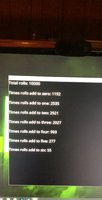Hey so I’m part of a team working on a mechanic for a video game in essence it uses dice rolls to determine certain outcomes and I have been tasked with finding out the probability of some of these. In short here’s the deal I hope I’m explaining it clearly enough.
I have three six sided dice the values of each dice face are as follows:
1=0
2=0
3=0
4=1
5=1
6=2
First question: what is the most likely value of rolling these three dice? (values of all three dice in total)
I have it as 2 seeing as 6 faces on each die and the total value across those faces is 4 so 4 divided by 6 is 0.66667, and three dice so 0.66667 times 3 is 2. Is this correct?
Second question if I roll these three dice once am I just as likely to roll a value of 2 or higher as in the following scenario:
Rolling the same three dice twice, but on the first roll for every value under 2 I roll one less die in the second roll, however for every value above 2 on the first dice roll I roll an additional dice on the second dice roll.
Only the values rolled on the second dice roll are counted.
For this I honesty have no idea where to begin working this one out could really use some help.
I have three six sided dice the values of each dice face are as follows:
1=0
2=0
3=0
4=1
5=1
6=2
First question: what is the most likely value of rolling these three dice? (values of all three dice in total)
I have it as 2 seeing as 6 faces on each die and the total value across those faces is 4 so 4 divided by 6 is 0.66667, and three dice so 0.66667 times 3 is 2. Is this correct?
Second question if I roll these three dice once am I just as likely to roll a value of 2 or higher as in the following scenario:
Rolling the same three dice twice, but on the first roll for every value under 2 I roll one less die in the second roll, however for every value above 2 on the first dice roll I roll an additional dice on the second dice roll.
Only the values rolled on the second dice roll are counted.
For this I honesty have no idea where to begin working this one out could really use some help.


